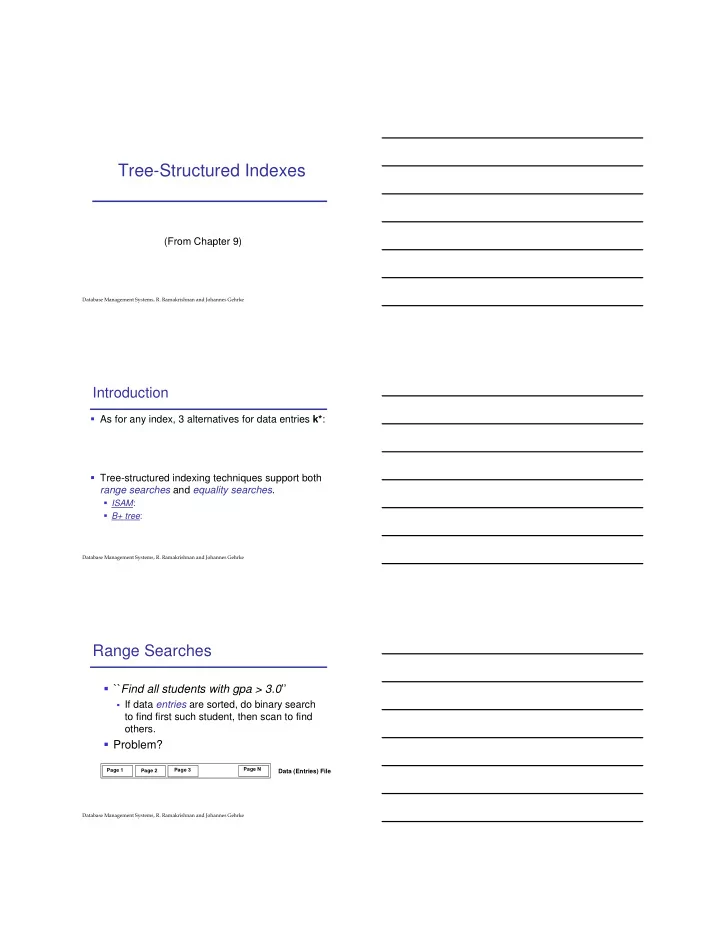

Tree-Structured Indexes (From Chapter 9) �������������������������������������������� ������������������� Introduction � As for any index, 3 alternatives for data entries k* : � Tree-structured indexing techniques support both range searches and equality searches . � ISAM : � B+ tree : �������������������������������������������� ������������������� Range Searches � `` Find all students with gpa > 3.0 ’’ � If data entries are sorted, do binary search to find first such student, then scan to find others. � Problem? Page N Page 1 Page 3 Page 2 Data (Entries) File �������������������������������������������� �������������������
Range Searches � Simple idea: Create an `index’ file � What is search cost if each index page has F entries? Index File kN k1 k2 Data File Page N Page 1 Page 3 Page 2 � ��������������������������������������������� �������������������������������������������� ������������������� index entry ISAM P0 K 1 P 1 K 2 P m P 2 K m � Index file may still be quite large. But we can apply the idea repeatedly! Non-leaf Pages Leaf Pages Overflow page Primary pages � ������������������������������� � �������������������������������������������� ������������������� Example ISAM Tree � Each node can hold 2 entries � What is search cost if each leaf node can hold L entries and each index node can hold F entries? Root 40 20 33 51 63 46* 55* 10* 15* 20* 27* 33* 37* 40* 51* 63* 97* �������������������������������������������� �������������������
After Inserting 23*, 48*, 41*, 42* Root 40 Index Pages 20 33 51 63 Primary Leaf 10* 15* 20* 27* 33* 37* 40* 46* 51* 55* 97* 63* Pages 48* 41* Overflow 23* Pages 42* �������������������������������������������� ������������������� … Then Deleting 42* Root 40 Index Pages 20 33 51 63 Primary Leaf 46* 55* 10* 15* 20* 27* 33* 37* 40* 51* 63* 97* Pages 48* 41* Overflow 23* Pages 42* �������������������������������������������� ������������������� … Then Deleting 51* Root 40 Index Pages 20 33 51 63 Primary Leaf 46* 55* 10* 15* 20* 27* 33* 37* 40* 51* 63* 97* Pages 41* 23* 48* Overflow Pages �������������������������������������������� �������������������
After Deleting 41* and 51* Root 40 Index Pages 20 33 51 63 Primary Leaf 10* 15* 20* 27* 33* 37* 40* 46* 55* 97* 63* Pages 48* 41* Overflow 23* Pages � ���������������������������������������������������� �������������������������������������������� ������������������� B+ Tree: The Most Widely Used Index � Insert/delete at log F N cost � Minimum 50% occupancy (except for root). � Supports equality and range-searches efficiently. Index Entries (Direct search) Data Entries ("Sequence set") �������������������������������������������� ������������������� Example B+ Tree � Search begins at root, and key comparisons direct it to a leaf (as in ISAM). � Search for 5*, 15*, all data entries >= 24* ... Root 13 17 24 30 33* 34* 38* 39* 2* 3* 5* 7* 14* 16* 19* 20* 22* 24* 27* 29* �������������������������������������������� �������������������
B+-tree Search Performance � Assume leaf pages can hold L data entries � Assume B+-tree has order d � Assume the tree has to index N data entries � What is the best-case search performance (measured in number of I/Os)? � What is the worst-case search performance? �������������������������������������������� ������������������� B+ Trees in Practice � Typical order: 100. Typical fill-factor: 67%. � average fanout = 133 � Typical capacities: � Height 4: 133 4 = 312,900,700 records � Height 3: 133 3 = 2,352,637 records � Can often hold top levels in buffer pool: � Level 1 = 1 page = 8 Kb � Level 2 = 133 pages = 1 MB � Level 3 = 17,689 pages = 133 MB �������������������������������������������� ������������������� Inserting 23* Root 13 17 24 30 2* 3* 5* 7* 14* 16* 19* 20* 22* 24* 27* 29* 33* 34* 38* 39* �������������������������������������������� �������������������
Inserting 8* … Root 13 17 24 30 2* 3* 5* 7* 14* 16* 19* 20* 22* 24* 27* 29* 33* 34* 38* 39* �������������������������������������������� ������������������� Inserting 8* …Leaf Page Split �������������������������������������������� ������������������� Inserting 8* …Root Split �������������������������������������������� �������������������
After Inserting 8* Root Note how tree grew by one level! 17 5 13 24 30 33* 34* 38* 39* 2* 3* 5* 7* 8* 14* 16* 19* 20* 22* 24* 27* 29* �������������������������������������������� ������������������� Inserting 8* … Root 13 17 24 30 34* 38* 39* 2* 3* 5* 7* 14* 16* 19* 20* 22* 24* 27* 29* 33* � In this example, could have “redistributed” to sibling instead of splitting � Not usually done in practice (Why?) �������������������������������������������� ������������������� Deleting 19* … Root 17 5 13 24 30 2* 3* 5* 7* 8* 14* 16* 19* 20* 22* 24* 27* 29* 33* 34* 38* 39* �������������������������������������������� �������������������
Deleting 20* … Root 17 5 13 24 30 33* 34* 38* 39* 2* 3* 5* 7* 8* 14* 16* 20* 22* 24* 27* 29* �������������������������������������������� ������������������� Deleting 20* … Root 17 5 13 24 30 2* 3* 5* 7* 8* 14* 16* 22* 24* 27* 29* 33* 34* 38* 39* �������������������������������������������� ������������������� After Deleting 20* Root 17 5 13 27 30 2* 3* 5* 7* 8* 14* 16* 22* 24* 27* 29* 33* 34* 38* 39* �������������������������������������������� �������������������
Recommend
More recommend